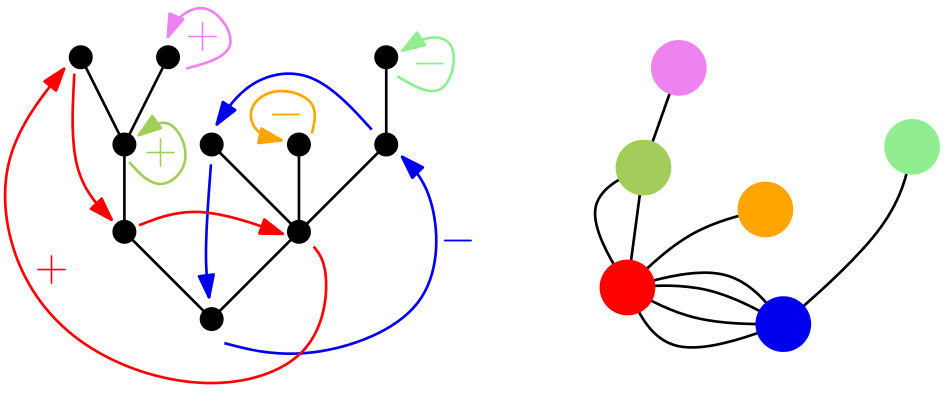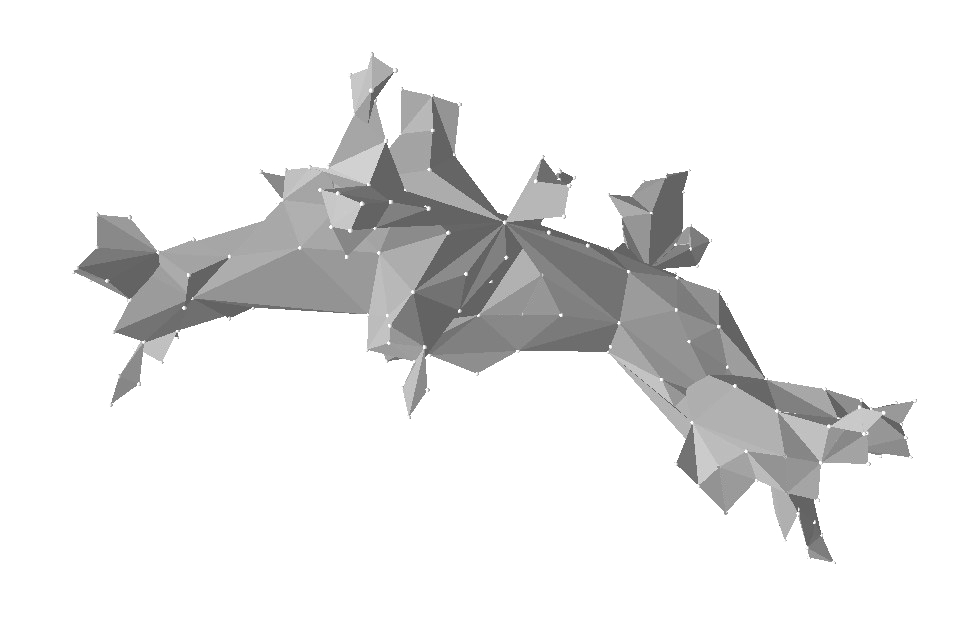Journées Cartes des 20-21 juin 2013
Les journées Cartes se sont tenues les jeudi 20 et vendredi 21 juin 2013 à l'Institut de Physique Théorique, CEA Saclay, juste avant FPSAC. Voici quelques explications sur les moyens d'accès à l'IPhT.
The "journées Cartes" are bimestrial meetings devoted to combinatorial maps and related topics, and a session has been held on June 20th and 21st at the Institut de Physique Théorique, CEA Saclay, right before FPSAC. Here are some explanations (in English) on how to reach the venue.
Programme
| Jeudi 20 juin / Thursday, June 20 | |||
| 10:00-11:00 | Olivier Bernardi | Counting one-face maps and one-face constellations | |
| 11:30-12:30 | Marie Albenque | Convergence of simple triangulations | |
| 14:00-15:00 | Timothy Budd | From planar maps to spatial topology change in 2d gravity | |
| 15:00-16:00 | Mathieu Guay-Paquet | Jucys-Murphy elements and Monotone Hurwitz numbers | |
| Vendredi 21 juin / Friday, June 21 | |||
| 10:00-11:00 | Gourab Ray | Domain Markov half planar maps | |
| 11:30-12:30 | Gaëtan Borot | Topological recursion : computing asymptotics of knot invariants like counting maps ? | |
| 14:00-15:00 | Guillaume Chapuy | What about maps in complex reflection groups ? | |
| 15:30-16:30 | François David | Conformal spatial point processes and planar maps | |
Organisateurs : Jérémie Bouttier, Gilles Schaeffer
Soutien : ERC ExploreMaps (ERC StG 208471), ANR Cartaplus (12-JS02-001-01)

| 
|
Titres et résumés
- Marie Albenque, Convergence of simple triangulations (PDF) :
Asymptotic behaviour of large random maps has been largely investigated in the last few years. In particular, Miermont and Le Gall defined in 2011, the so-called "Brownian map" and proved that triangulations and 2p-angulations -- properly rescaled -- converge towards this object. In this this talk, I'll show that simple triangulations, that is triangulations without loops nor multiple edges, converge as well towards the Brownian map after proper renormalization.
Our two main motivations for studying this particular model of maps are the following : all "reasonable" classes of maps are believed to converge towards the Brownian map and this result is the first one where convergence is obtained for a model of maps with a connectivity constraint and which relies on a bijective construction between simple triangulations and blossoming trees obtained by Poulalhon and Schaeffer different from the bijections used classically. Secondly, since simple triangulations admits a unique representation as a circle packing in the sphere, studying the circle packing associated to large random simple triangulations could yield some conformal properties of the Brownian map.
This is joint work with Louigi Addario-Berry (McGill University). - Olivier Bernardi, Counting one-face maps and one-face constellations (PDF) :
We consider the problem of counting one-face maps with n edges according to their genus. The Harer-Zagier formula ``solves'' this problem for maps on orientable surfaces. More precisely, it gives a simple expression for the generating function of one-face maps with n edges on orientable surfaces, counted according to their genus. In this talk we consider some generalizations.
First we consider the case of maps on general surfaces and give an analogue of the Harer-Zagier formula. Then we consider the case of bipartite maps and constellations (generalizations of maps in which the edges are replaced by d-gons). Our proofs are combinatorial, and partially based on ideas due to Bodo Lass (which are also implicitly present in constructions by Goulden and Nica, and by Schaeffer and Vassilieva).
Part of the talk is joint work with Alejandro Morales. - Gaëtan Borot, Topological recursion : computing asymptotics of knot invariants like counting maps ? (PDF)
It is well-known that generating series of maps can be represented as an integral over the space of hermitian matrices M of size N, of the form (1) : dM exp(- NTr V(M)). The same is true for maps carrying self-avoiding loops, by allowing measures of the form (2) : dM exp(- NTr V(M) + Tr U(M \otimes 1,1 \otimes M)). Those matrix models also appear in Chern-Simons theory on certain 3-manifolds, although the fact has not been related to maps yet.
The enumeration of maps (possibly carrying self-avoiding loops) of all topologies satisfies a topological recursion. Actually, the recursive formula is universal : as a special case it governs the the large N expansion of all matrix models of type (2) (and thus enumerates maps) ; but it also appears in many other problems unrelated to matrix integrals.
The talk will be an introductory exposition of two relations between the topological recursion and the computation of asymptotics knot invariants (which will be defined) :- a theorem on the computation of the large N expansion of SU(N) knot invariants of torus knots.
- a conjecture on the computation of the asymptotic expansion of the n-colored Jones polynomial J_n(q = e^{2u/n}) of hyperbolic knots, in the limit n->infinity.
- Timothy Budd, From planar maps to spatial topology change in 2d gravity (PDF)
- Guillaume Chapuy, What about maps in complex reflection groups ? (PDF)
It is well known that maps on surfaces (e.g. on the sphere) can be encoded by "factorizations of the identity" in the symmetric group. For example, one way to state Cayley's formula for labeled trees is to say that the number of factorizations of the full cycle (1,2,...,n) into (n-1) transpositions is n^(n-2). I will talk about two generalizations of this result. The first one is due to Jackson, Shapiro, Shapiro and Vainshtein and deals with factorizations of "higher genus" g>0. The second one, where one replaces the symmetric group S_n by any finite subgroup of GL_n generated by reflections, and the long cycle by a "Coxeter element" is due to Deligne, and Bessis. I will then present our new result, that generalizes both results simultaneously : we treat the case of "higher genus" factorizations in arbitrary well-generated complex reflection groups (in particular, in finite Coxeter groups). This suggests that other aspects of map enumeration could be generalized to this setting.
This is joint work with Christian Stump (Berlin). The talk will assume no prior knowledge on any of the subjects involved. - François David, Conformal spatial point processes and planar maps (PDF)
- Mathieu Guay-Paquet, Jucys-Murphy elements and Monotone Hurwitz numbers (PDF) :
Jucys-Murphy elements are elements of the group algebra of the symmetric group. They are particularly interesting because their definition is combinatorially simple (as certain sums of transpositions), but so are their representation-theoretic properties.
Monotone Hurwitz numbers count solutions to a certain transposition factorization problem in the symmetric group which arises naturally when dealing with Jucys-Murphy elements, and they have applications to the computation of unitary matrix integrals.
We will discuss some properties, results, and open questions surrounding monotone Hurwitz numbers, including the monotone join-cut equation, a bijection with ordered trees, and a sorting algorithm for products of transpositions.
This talk is based on joint work with Ian Goulden and Jonathan Novak. - Gourab Ray, Domain Markov half planar maps (PDF) :
We study maps with an infinite simple boundary enjoying two natural properties : translation invariance and a version of the domain Markov property. We provide a complete classification of such maps and show that for simple faced maps such measures form a one parameter family. For the triangulation case, we also show that there exists a phase transition at a certain value of the parameter. Some results regarding the geometry of such triangulations are also obtained. Joint work with Omer Angel.

